Dorylus (Anomma) burmeisteri (Shuckard)
 Male Male   Type location Sierra
Leone (Anomma Burmeisteri, Shuckard, 1840c: 326, worker,
also illustrated by Santschi, 1912b; Raignier & van Boven, 1955:
93, queen; Emery, 1895j: 710, listed the male D. nigricans as a
synonym, that probably was erroneous) collector D.F. Morgan Type location Sierra
Leone (Anomma Burmeisteri, Shuckard, 1840c: 326, worker,
also illustrated by Santschi, 1912b; Raignier & van Boven, 1955:
93, queen; Emery, 1895j: 710, listed the male D. nigricans as a
synonym, that probably was erroneous) collector D.F. Morgan
junior synonyms
hybrida (D. A.
nigricans Ill. stirps Burmeisteri
var. hybrida n. var.,
Santschi, 1912b: 161, illustrated, major & minor workers; named as hybridus
by Wheeler, 1922: 738) from Senegal, collected at Casamance, by
Claveau - see linked workers page
pallidus (D. A.
nigricans Ill. stirps Burmeisteri
var. pallida n. var.,
Santschi, 1912b: 160; Santschi, 1921c: 115, major & minor workers)
from Cameroun - see http://www.antweb.org/specimenImages.do?code=casent0911313;
a media 1 worker, labelled "rubellus pallida but matching the
media 1 worker from Guinea, other than the pale colour suggesting it is
a callow (newly emerged) specimen.

|
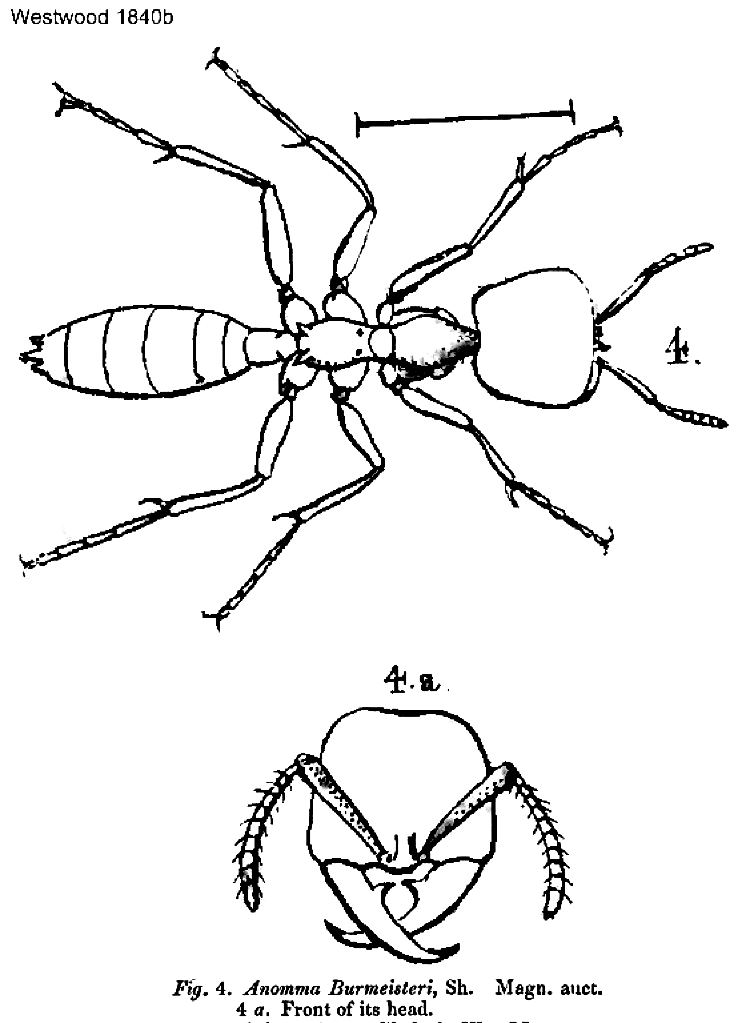 Shuckard's description
was in comparison with already
described members of Typhlopone and led him to define a new
subgenus Anomma. The defining characteristics were - a head
with its greatest width forward about the level of the base of the
mandibles; thorax [alitrunk] with a promesonotal fosse ("the thorax
being constricted especially at the sutural separation between pro- and
mesothorax") [what I call a "saddle"]; the peduncle of the abdomen
[petiole] is very narrow. His description is at Shuckard's description
was in comparison with already
described members of Typhlopone and led him to define a new
subgenus Anomma. The defining characteristics were - a head
with its greatest width forward about the level of the base of the
mandibles; thorax [alitrunk] with a promesonotal fosse ("the thorax
being constricted especially at the sutural separation between pro- and
mesothorax") [what I call a "saddle"]; the peduncle of the abdomen
[petiole] is very narrow. His description is at  Westwood, who clearly a working
relationship with Shuckard, provided the drawing (right) of a major
worker (Westwood, 1840b: Plate II, Fig 4). Westwood, who clearly a working
relationship with Shuckard, provided the drawing (right) of a major
worker (Westwood, 1840b: Plate II, Fig 4).
The description of burmeisteri from a soldier
specimen from Sierra Leone (D.F. Morgan, Shuckard, 1840; also
illustrated by Santschi, 1912b) was cited by Raignier & van Boven
(1955) was -
TL 12.72 ["six lines", 1.5 lines = 3.18 mm]; nigro-piceus, nitidus,
glaberrimus ; antennis pedibusque rufo-piceus. Brightly shining,
perfectly smooth, pitchy black, with the antennae, legs, thorax,
ventral incisures and the sides of the abdomen pitchy red. The
following are the proportions of this remarkable insect : length of
head, including mandibles 2 1/4 lines (4.75mm); thorax 1 1/2 lines
(3.18 mm); abdomen, including the peduncle 2 1/4 lines (4.76 mm)."
Roger (1861) observed how the size was very variable and the form of
the mandible changed with the reduction in size. This variation was
unappreciated by most of the early authors, but not by Savage (see
below) and led to much confusion in the early recognition of "species"
that were no more than the media or minor forms of the subgenus members.
|
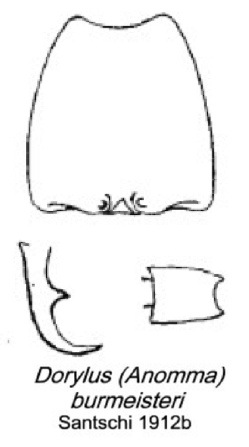 Dorylus (Anomma)
nigricans Ill. st. Burmeisteri
var. pallida n. var. Santschi (1912b). The argument on colour
variation applies equally to pallidus which is known only from
the original description of a specimen from Cameroun. His
description is at Dorylus (Anomma)
nigricans Ill. st. Burmeisteri
var. pallida n. var. Santschi (1912b). The argument on colour
variation applies equally to pallidus which is known only from
the original description of a specimen from Cameroun. His
description is at  and his notes on hybrida
are at and his notes on hybrida
are at  . Emery's (1881a)
described the various morphs, with illustrations, which also match the
specimens shown here; his descriptions are on . Emery's (1881a)
described the various morphs, with illustrations, which also match the
specimens shown here; his descriptions are on  and and  . .
In Guinea (Bernard, 1952) noted - typical form,
dark red, head often black, abundant at N'Zo, 500 m, several workers at
Yanlé (station F19). ssp. arcens, black and more matt, head
more convex, large worker from Yalanzou, purely a western form. ssp. burmeisteri
red and matt, more widespread, reaching 2400 m, at the peak of Fernando
Po - Lamotte took several minor workers in his transects but never
found a colony; common at Yanlé, Nion, N'Zo (rare), Camp I of Mount Tô
(1600 m, abundant). Note Bernard reassigned the variety molesta
"after Santschi" to Dorylus
stanleyi (known only from males); I have revived Dorylus molestus
as the definitive species; with antinorii, a junior synonym
from Ethiopia.
On their collection 22, Raignier & van Boven (1955,
p 71) noted - 21 workers, TL 13-4.1 mm, majors with head partially
shiny and posterior angles distinct and raised (but without teeth);
petiole glabrous and with very small posterior angles, CI 92 and
petiolar index 78 (width/length X 100); determination based
especially on the shiny head of the media workers. Collection 23,
29 workers, was similar, TL 11-3.2 mm, all with head shiny; the biggest
with raised angles to the head but less sharp than sjostedti,
adding that the latter character was variable among "nigricans".
Hollingsworth (1960, illustrated, but somewhat different
to my drawing from CRIN, see bottom), based at the University College
of Ghana, Legon, studied the polymorphism of the workers and concluded
there was diphasic allometry, with a continuous series of sizes from
the smallest to the largest.
|
 Queen - From their detailed study of queens,
Raignier & van Boven (1955) decided that the definition by Forel
(1912j) was actually of a specimen identical with that of Dorylus (Anomma)
molestus, as described by Mayr (1896?). They provided a full
description and monochrome photograph (left) of the burmeisteri queen. Queen - From their detailed study of queens,
Raignier & van Boven (1955) decided that the definition by Forel
(1912j) was actually of a specimen identical with that of Dorylus (Anomma)
molestus, as described by Mayr (1896?). They provided a full
description and monochrome photograph (left) of the burmeisteri queen.
|
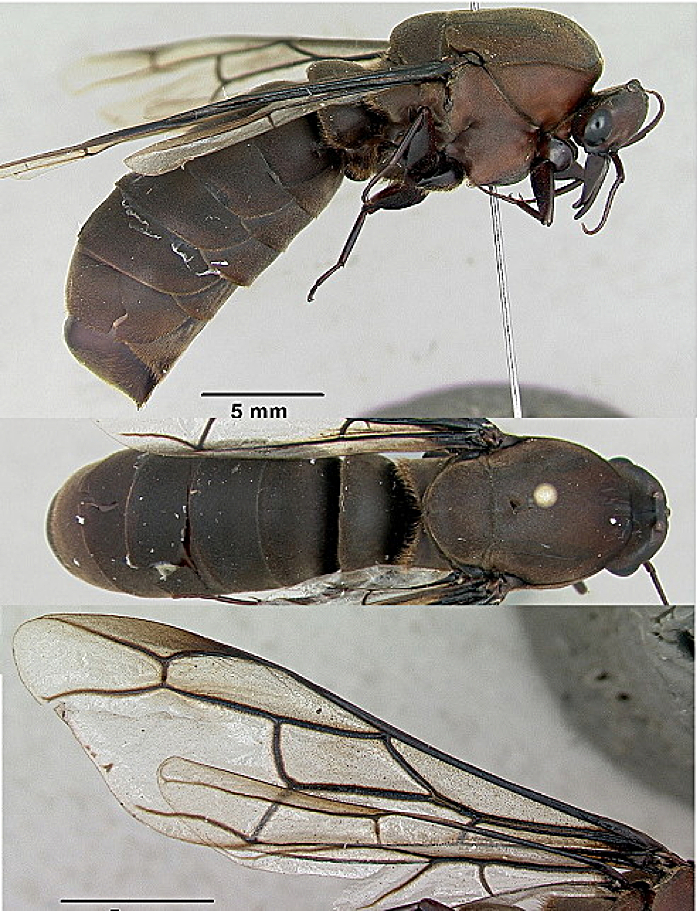 Males Males
These match Emery (1910) - no frontal sulcus, occiput domed; from above
front of head is convex; scape length to basal 6.3 segments of
funiculus; SL = distance between inner margin of eye and outer edge of
median ocellus (in full face view scape does not reach the faint median
line); EW/EL = 71/66; posterior margin of petiole is shallowly concave;
without any fringing hairs (Antweb specimen from different angle to my
two; apex of gaster shallowly concave, with the stipes barely visible.
See the Dorylus (Anomma)
burmeisteri males page.
Forel (1909b: 11) in his notes on emeryi noted "nigricans"
- MALE - HW 5.0, alitrunk 6.0, gaster 5.6 mm.
|
Oxford University Museum
specimens
Dorylus (Anomma) burmeisteri
B Taylor det.
|
Benin
S Tchibozo
Benin 16
|
27.viii.2006
Bonou
06°50-55' N
02°20-30'E
|
Forêt de
Gnanhouizoumè, Pitfall trap
|
5
|
 |
Dorylus (Anomma) burmeisteri
B Taylor det. |
Guinea
T Humle
Humle 03
|
24.iii.2001
Bossou
7°39'57 N
8°25'08 W
|
|
3
|
 |
Dorylus (Anomma) burmeisteri
B Taylor det. |
Guinea
T Humle
Humle 13
|
11.viii.2001
Bossou
7°39'57 N
8°25'08 W
|
|
2
|
 |
Dorylus (Anomma) burmeisteri
B Taylor det. |
Guinea
T Humle
Humle 02
|
2.ix.2001
Bossou
7°39'57 N
8°25'08 W
|
hand collected
|
2
|
|
Dorylus (Anomma) burmeisteri
B Taylor det. |
Guinea
T Humle
Humle 11
|
24.viii.2001
Bossou
7°39'57 N
8°25'08 W
|
hand collected
|
2
|
 |
Dorylus (Anomma) burmeisteri
B Taylor det.
|
Cameroun
G Debout & A Dalecky
Cameroon 104
|
24.iv.2001
Nkolobondé
3°14' N
10°15' E
|
on trail, near
secondary growth fields
|
4
|
 |
Dorylus (Anomma) burmeisteri
B Taylor det. |
Cameroun
G Debout & A Dalecky
Cameroon 11
|
24.iii.2001
EBO-TE
2°33.98' N
9°50.67' E
|
on soil and surface
in forest understorey
|
3
|
 |
Dorylus (Anomma) burmeisteri
B Taylor det. |
Central African
Republic
P Annoyer
GL-01
|
22.ii.2005
Dzanga-Sangha
02°55’04.8" N
16°10’09.7" E
|
Camp 6; A vu dans
une petite saline aux abords du camp, 12h-16h; 450 m asl
|
7
|
 |
Dorylus (Anomma) burmeisteri
B Taylor det. |
Central African
Republic
P Annoyer
GV
|
Dzanga-Sangha
|
sur bane de sable
milieu de la Sangha
|
1
|
 |
Dorylus (Anomma) burmeisteri
B Taylor det.
Male
|
Central African
Republic
P Annoyer
1998-08
|
3.vi.1998
Dzanga-Sangha
|
Bayanga-Lidjombo;
U.V. 19h-05h; LAYON PK 21 5.0 RCA
|
1
|
 |
Dorylus (Anomma) burmeisteri
B Taylor det. |
Central African
Republic
P Annoyer
1998-01
|
27.v.1998
Dzanga-Sangha
|
Boda-N'Goto;
1800-0500h; U.V; PK 35, RCA
|
1
|
 |
Dorylus (Anomma) burmeisteri
B Taylor det.
|
Kenya
M Snizek
|
24.xii.1999
Taita
03°25' S
38° 20' E
|
SE, Taita, Mwatate
Env.
|
4
|
 |
|
|
Polymorphism
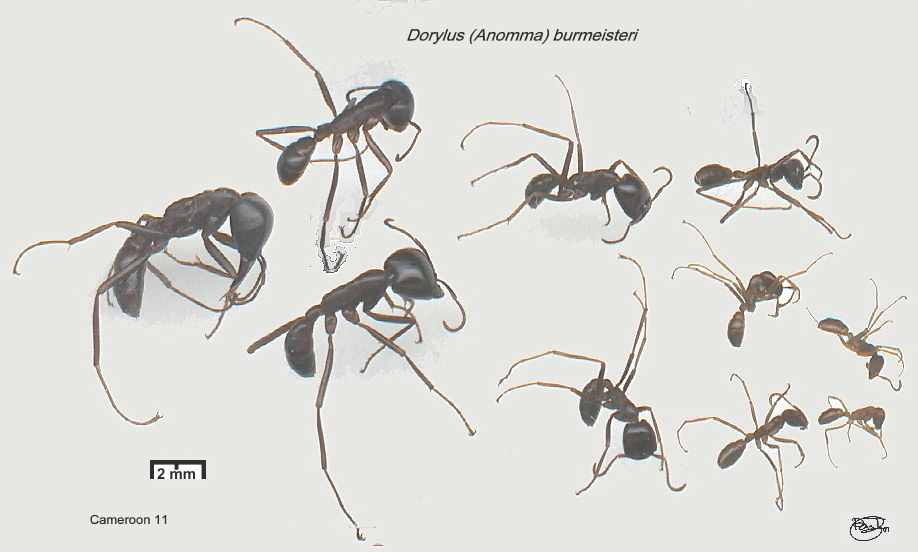 The specimens in the photomontages are from Bossou, south
eastern Guinea, collector
Tatyana Humle (Humle 13); or Cameroun - south-western tropical
coastal
forest area between Edéa and Campo (McKey Wolbachia
project,
Cameroon 11). The specimens in the photomontages are from Bossou, south
eastern Guinea, collector
Tatyana Humle (Humle 13); or Cameroun - south-western tropical
coastal
forest area between Edéa and Campo (McKey Wolbachia
project,
Cameroon 11).
The various morphs
are shown in detail on the Dorylus
(Anomma) burmeisteri morphs page.
|
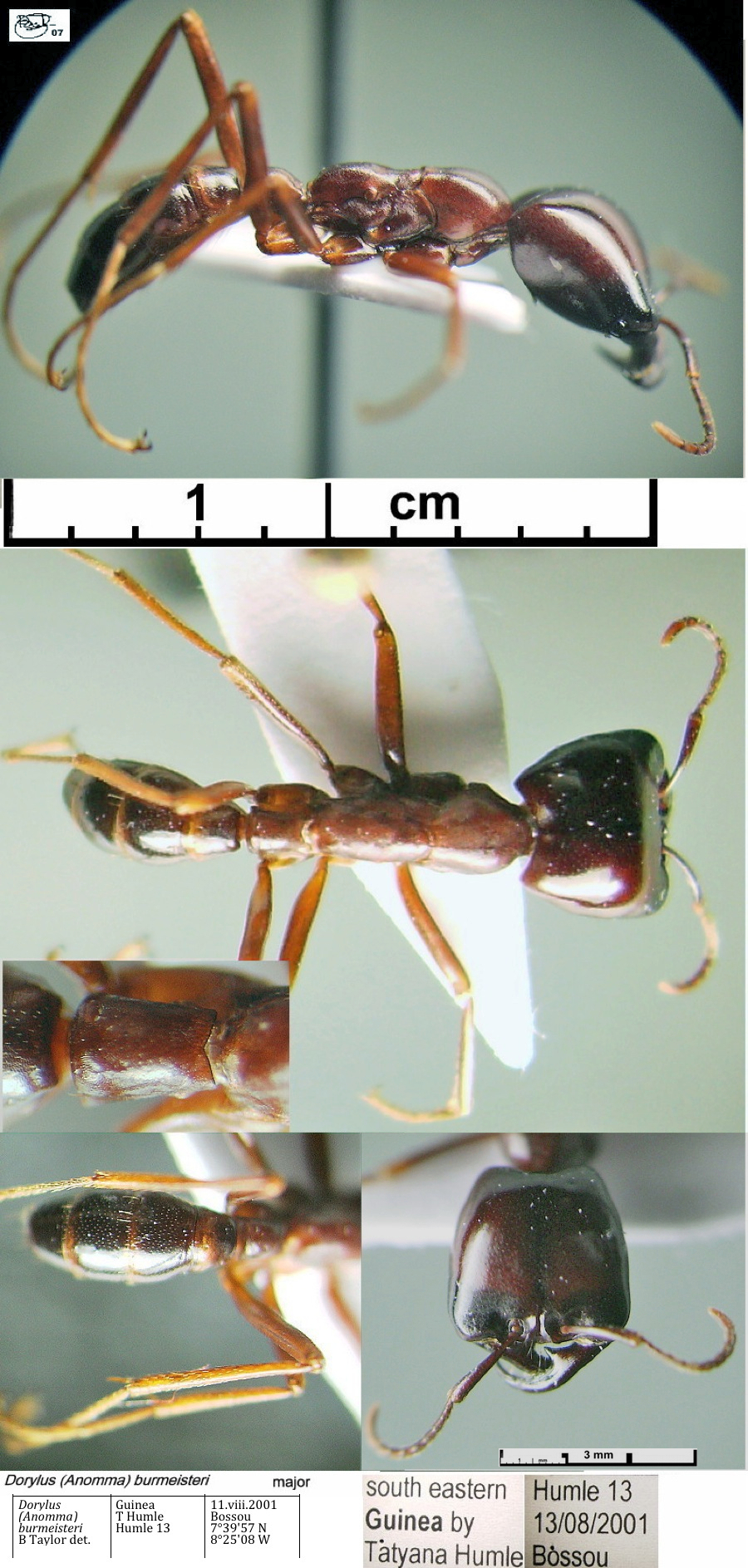 Full new description - Cameroon
11, Humle 13 ( major shown top right) Full new description - Cameroon
11, Humle 13 ( major shown top right)
Overall - shiny matt, posterior gaster shiny dark chestnut, head and
gaster darker but unicoloured
Cameroon 11 - TL 10.1 HW 2.75 HL 2.6 HD 1.8 CI 106 SL 1.25 SI 48 AL
3.25 PW 1.0 PetL 0.75 GL 3.5 MFL 2.4
Humle 13 - TL 10.05 HW 3.0 HL 2.6 CI 115 HD 2.0 SL 1.6 SI 61 AL 3.25 PW
1.0 PetL 0.7 GL 3.5 MFL 2.4
Head - subrectangular, widest about mid-length but only slightly wider
than anterior margin; sides convex, first one-sixth angled out from
anterior margin, then near straight to mid-length before curved
narrowing, occipital border no more than 60% maximum width; posterior
border moderately shallow scallop; sculpturation of extremely fine
spiculation, almost effaced on posterior half of face, which has minute
sparse hair pits; median line visible only on anterior half of face and
slightly impressed forward; clypeal margin sinuous medially extended,
with long moderately fine median straight hair, others (worn away)
laterally; mandible moderately long and fairly slender, subapical teeth
reduced to denticle, basal tooth triangular, interior hairs (worn
away); scape moderately thick, progressively so from base to apex, apex
itself somewhat swollen with rounded corners; funiculus basal segment
narrow, 2 slightly thicker, rest relatively stout, 3-9 near equisized,
apical 10 no more than twice 9; coarse pilosity giving bristly
appearance; in profile quite bulbous, with relatively short frontal
area, posterior corners rounded; very minute sparse pilosity on occiput.
Alitrunk - shallowly domed, all edges rounded, smooth drop from
one-third point of pronotum to almost back of propodeum; flat unbroken
line with pronotum and propodeum (more of a mesonotum step in Humle
13); spiracle circular distinctly rearward facing; propodeum with short
vertical declivity; metapleural gland upper flange only a little longer
than lower; very fine spiculation, as lateral head; no hairs except
micropilosity on shoulders.
Petiole - rel long, flattened dome with high point ca one-third from
front, posterior face a smooth curve from dorsum; dorsal view parallel
sided (posteroventral processes in Humle 13); spiracle moderate and
about halfway in petiole height; subpetiolar process a low triangle,
point at rear; sculpturation as alitrunk; hairs none on dorsum, lower
single pair mod long hairs several dorsally on one of two Humle 13.
Gaster - 1 & 2 with sculpturation as but finer than alitrunk;
waisted 1-2; hairs not many at all and those flat not erect.
Legs - coxae quite long and slender; femora relatively broad and flat,
matte; tibiae relatively wide, pilosity fine; tarsi moderately thick,
bristly, claws heavy.
|
 Minima morph Minima morph
Head densely spiculate, matt, colour uniformly dark brown; dorsum with
minute very sparse decumbent pilosity; funiculus with dense bristly but
very short pilosity; area between frontal carinae distinctly raised.
|
 Nigeria
specimens (Taylor, 1980b: 13). These seem
to vary from those I have recognized as burmeisteri and, so, I
have kept this section as a record. WORKERS. TL 10.88-3.86 mm. At least
five morphs; largest HL 2.72, HW 2.66, SL 1.39, PW 1.27, petiole length
1.00 Nigeria
specimens (Taylor, 1980b: 13). These seem
to vary from those I have recognized as burmeisteri and, so, I
have kept this section as a record. WORKERS. TL 10.88-3.86 mm. At least
five morphs; largest HL 2.72, HW 2.66, SL 1.39, PW 1.27, petiole length
1.00
Colour dark red-brown. All over sculpturation of very fine
reticulation. Several erect hairs on tergites, a pair on petiole dorsum
and several subpetiole. Head with maximum width at mid-length then
straight sided forward narrowing before the anterior margin. Antennal
scapes thickening to a moderately broad apex; funiculus with all
segments, except apical 10, near equisized and slightly longer than
broad. Mandibles with a long acute apical tooth and a simple triangular
preapical tooth subtended by a wrinkled inner margin running to a large
blunt basal tooth. Anterior clypeal margin with a low, blunt medial
extension; a long medial seta and a pair of moderately long hairs each
side of it. Head highly polished but with with very sparse minute
puncturations, and faint spiculation more dorsally and laterally.
Promesonotum convex dorsally. Subpetiolar process broad-based but low,
rear facing and blunt triangular.
Collected at the Cocoa Research Institute of Nigeria, Idi Ayunre.
|
Biology of "nigricans senso lato"
Often, cited (as nigricans) as being the subject
of the classic early paper by the Rev. T.S. Savage, a medical
missionary in West Africa, but that probably now can be separated as Dorylus rubellus.
Bernard (1952) wrote of "nigricans" as being the
most common and most confusing of all the Anomma, demanding of
revision when males of all forms were known.
It was described as occasionally found on Ghana cocoa,
probably as "chance migrants", by Strickland (1951a).
 Also later found throughout the Mampong
Cemetery farm by Room (1971); and listed, as Anomma nigricans,
from cocoa at Kade by Majer (1975, 1976b), with a single worker found
in a pkd sample. One of the two species studied during 1971 by Gotwald
(1974). He found it in all the areas he visited (coastal scrub, Guinea
savannah and high forest). The main prey in the drier areas was insects
(75%), mostly grasshoppers in the coastal area and a more mixed bag in
Guinea savannah. In high forest areas, especially in and around cocoa
at CRIG, the almost exclusive diet was earthworms. Also later found throughout the Mampong
Cemetery farm by Room (1971); and listed, as Anomma nigricans,
from cocoa at Kade by Majer (1975, 1976b), with a single worker found
in a pkd sample. One of the two species studied during 1971 by Gotwald
(1974). He found it in all the areas he visited (coastal scrub, Guinea
savannah and high forest). The main prey in the drier areas was insects
(75%), mostly grasshoppers in the coastal area and a more mixed bag in
Guinea savannah. In high forest areas, especially in and around cocoa
at CRIG, the almost exclusive diet was earthworms.
In Nigeria, I found burmeisteri foraging
at CRIN. Wheeler (1922) notes nigricans from Moor Plantation
and Agege (by Lamborn).
Studied in Congo by Raignier and van Boven
(1955), who calculated the egg production as 50,000,000 per year.
Schneirla (1971) summarized many of their findings. He noted that it
has been found at up to 3000 m asl in Sudan; the nests are 2-4 m below
ground and the colony may be bigger than that of D. wilverthi.
The periods of residence between migrations was longer than that of D.
wilverthi, perhaps being more typical of the subgenus.
Working at Lamto, in the Ivory Coast, Leroux
described colony size and nest habits; including an estimate of three
colonies per 10 ha in the forest; and noted how among the principal
predators are members of the subgenus Typhlopone and
Odontomachus troglodytes (1977, 1979).
Numerous other records in Wheeler (1922), include Ivory
Coast, Cameroun (many), and throughout tropical Africa.
Wheeler, who provided the illustrations (left and on linked page) noted
that the original descriptions (by Emery and Santschi had the largest
morphs at TL 13 mm. The dichthadiigyne female (queen) discovered in Uganda
measured 29 to 31 mm.
|
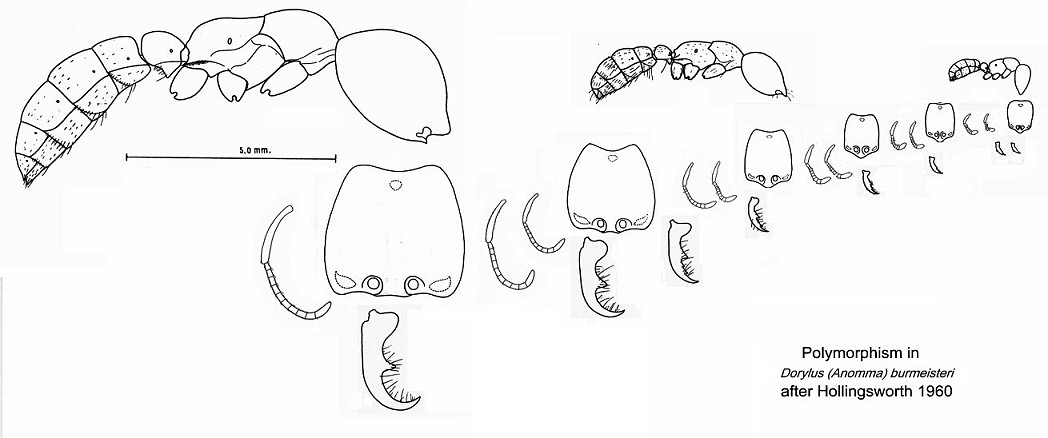
|